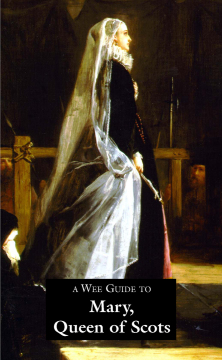Mary Queen of Scots: Final Years
Mary’s arrival in England presented Elizabeth with something of a constitutional dilemma, but Mary had no idea of this when she arrived at Workington. Mary had never
officially renounced her claim to the English crown, which annoyed Elizabeth, but Elizabeth could not be seen to support rebellion, and detaining Mary might be seen as tacit condonement of the action
of the Confederate Lords.
Mary was escorted to Carlisle Castle, not straight to London as she had hoped. Nevertheless Mary accepted this, and did not realize that Elizabeth had instructed the Earl of
Northumberland to guard her closely, and not only for her own protection. She also sent Sir Francis Knollys and Lord Scrope north as emissaries, not bearing an invitation south as Mary hoped, but to
explain Elizabeth’s position and her concerns about Darnley’s murder. Mary was allowed a number of her own household to join her at Carlisle, but as time passed her impatience increased and she wrote
numerous letters of complaint to Elizabeth and to France. Elizabeth would not have relished the prospect of Mary receiving French support, and so informed Mary that there would have to be an inquiry
into
the events in Scotland. At the same time she moved Mary further south to Bolton Castle in Yorkshire. Mary sent some of her supporters back to Scotland in the hope that they would be able to revive
her position and popularity there. Although Mary continued to have support throughout her captivity, it was an ever decreasing force and had lost momentum, and its figurehead, when she fled
south.
At Bolton, although aware she was to all intents a prisoner, Mary did receive occasionally hopeful items of news. Moray was not a popular Regent and Huntly and Argyll still hoped
to overthrow him. The Cardinal of Lorraine and Charles IX of France assured her of support, which was in the event to prove more theoretical than real.
Mary was offered the opportunity to have her case heard by Elizabeth – if she would renounce her claim to the English crown, to which Mary agreed. She also agreed to Elizabeth’s
condition that she break off communications and alliances with France; and finally she was to forbid the celebration of the Mass in Scotland, although Mary herself would be permitted to worship in
private as her faith dictated.
Mary agreed to all these conditions, believing that she would be proved innocent of all charges, but this illusion was shattered when she was informed of two unsettling facts.
Firstly she was not to be allowed to attend the inquiry herself, and secondly Moray and Morton had sent south the infamous Casket Letters, which purported to contain love letters between Mary and
Bothwell, showing that they were lovers before Darnley was killed.
These letters disappeared soon after the York inquiry, but their authenticity has always been doubtful, especially as those who discovered (or doctored) them had so much to gain
from anything that blackened Mary’s name. Thus Morton and his able assistant, George Buchanan, whose blatant allegiance to Morton and use of anti-Mary/anti-Hamilton propaganda, make his evidence
suspect, used the letters to add weight to their case. Whether or not the letters were complete fakes or were merely doctored a little, is now of little importance, as they were not even produced at
York. In the end Elizabeth decided that neither side had proved their case adequately, but Mary’s reputation was sufficiently sullied to justify keeping her captive. The casket which was supposed to
have held the letters is now kept at Lennoxlove House in East Lothian.
Meanwhile back in Scotland, Mary’s cause was not entirely lost and would not be until 1573; several of her nobles never joined the King’s party, particularly Huntly and
Châtelherault. The two parties did not divide simply along religious lines; although the King’s party supported the reformed church, there were both Catholics and Protestants on Mary’s side.
Often the divide occurred along political and old dynastic rivalries. As Regent Moray had not consolidated his powerbase, therefore his assassination at Linlithgow on 23 January
1570, organized by the Hamiltons, was not unexpected. Lennox, Darnley’s father, was appointed Regent next, but his agenda of revenge against Darnley’s murderers did not make him a more popular
choice. The north-east was held for Mary by Huntly, the west by the Hamiltons and Edinburgh Castle by Kirkcaldy of Grange and Maitland. Despite the Queen’s party holding a parliament in the Tolbooth
in Edinburgh in June 1571, the rival party increased its support as more of the nobles changed their allegiance.
The King’s party was tightly controlled by the Earl of Morton, James Douglas, although he was not officially appointed regent until 1572. With English help, Morton attacked
Edinburgh Castle, and on its fall Kirkcaldy of Grange was hanged. Maitland was saved this fate by dying, possibly by poison, before being captured. In 1571 Archbishop John Hamilton – who was on
Mary’s side – was captured, and later hanged, during the seizure of Dumbarton Castle by the King’s troops. Châtelherault and Huntly agreed to peace terms at Perth in 1573, and over the next three
years Argyll (1574), Châtelherault (1575) and Huntly (1576) all died, leaving the governing of the country to Morton, who managed to impose a period of relative tranquillity on the country.
Morton’s personality and style of government did not mean that he did not have any problems or create enemies. Old feuds lingered, and combined with Morton’s disastrous financial
and pro-English policies, contributed to his own
overthrow as Regent in 1578. He was eventually arrested, and executed in 1581 for his part in the murder of Darnley. Aberdour Castle in Fife was one of the Earl of Morton’s castles.
Mary, in England, had her own problems. She was moved to Tutbury Castle in 1569, and to several other locations over the next few years. Her captors and conditions were as varied
as the locations; sometimes more friendly, at others distant and rigid. She was allowed to have some of her own household with her during her captivity, and she was allowed visitors and
communications from outside, but she did not have freedom to come and go as she wished, and spies reported on her movements and communications. Her health also deteriorated during her imprisonment, a
deterioration possibly contributed to by the damp conditions of some of the accommodation and by a lack of regular exercise. There are reports of a rheumatic-like condition, associated with fever,
for which she visited the thermal baths at Buxton Wells on several occasions. In the 1580s she had several episodes of dropsy, when her legs became swollen and weak, and throughout the latter years
of her life Mary required frequent visits and treatments from a number of physicians.
Mary was still, as she had been throughout her life, an enigma and a fascination to many men. She was not above using her power and influence over them to manipulate and attempt to
alter her circumstances, and there were several episodes of plotting and attempts at escape during her years of confinement. One episode, in 1571, involved the Duke of Norfolk and included a proposal
for a marriage between himself and Mary. Messages were sent to Rome asking for an annulment from Bothwell, who was still alive although in prison. The episode is also known as the Ridolfi Plot, as
Spanish support was also expected to help raise the Catholics in England.
The plot was discovered and Elizabeth had Norfolk imprisoned in the Tower of London and later executed. Another marriage plan was instigated by the Pope, who suggested Philip II’s
half-brother Don John of Austria, but he died of typhus. Events outwith England also contributed to Mary’s precarious popularity; on 24 August 1572, on the eve of the Feast of St Bartholomew,
thousands of Protestants were slaughtered in Paris. As a result there was an increase of anti-Catholic feeling throughout Europe and in England with reminiscences of the brutalities of Mary Tudor’s
reign, and distrust of Mary Stewart increased, especially as rumours about her plotting spread.
Elizabeth, in contrast, actually became a little more lenient to Mary at this time, and allowed her to be moved to Chatsworth Hall because her health had deteriorated, and over the
next years she spent her captivity at Buxton, Chatsworth and Sheffield. With fear of Catholic plots abounding, Elizabeth appointed Sir Francis Walsingham to root out any treasonable plans. He was a
stern Protestant and determined to use whatever means necessary to rid Elizabeth of Catholic dangers, especially Mary.
Walsingham enrolled the services of a former Catholic priest Gilbert Gifford, who then asked for an audience with Mary. He told her that he was in touch with her continental
friends and offered to smuggle letters out to them. Mary was by this time held at Chartley Hall and had suffered quite a serious bout of illness. She may have been physically and emotionally
vulnerable and so less cautious. In 1586, a local brewer appeared, organized by Gilbert Gifford, bearing a secret letter from her supporters on the continent. Mary dictated a reply to her French
secretary, Claud Nau, who translated them into code and gave them to the brewer to pass on. The letters did not go straight to their intended destination, but were instead re-routed via Walsingham
who, from now on, was privy to all Mary’s communications.
In June 1586 Mary was in touch with the leader of a group of Catholics, Sir Anthony Babington, who wrote describing details of his plan to assassinate Elizabeth and place Mary on
the throne. Mary was aware that if she approved of his plan, and it was a failure, then she would suffer serious consequences. She was advised not to reply to Babington, but at the same time her
alternative hopes for a return to Scotland had been abruptly interrupted.
Mary’s son James was now twenty, and although she had written him affectionate letters there was probably never a real closeness between them. James had been brought up as a
Protestant and taught to distrust his mother by his tutor George Buchanan. In the summer of 1586 he had signed an Anglo-Scottish agreement, whereby Elizabeth would name James as her successor and
grant him a pension, in return for peace between the two countries.
Mary was very disappointed when she heard this news, and it may have contributed to her rashness in conveying her approval to Babington, which information was in turn, of course,
received by Walsingham and Elizabeth. On 11 August Mary was allowed to go out on a hunt, much to her surprise; but during the day she was confronted with the news that Elizabeth knew of the plot. Her
rooms had been searched for evidence, and her servants arrested – they later confessed. Babington had been tried and executed in London. Mary’s last attempt at freedom had failed and she was removed
to Fotheringhay Castle on 24 September 1586, where she was to stand trial for her part in a plot to destroy Elizabeth.
The trial started on 15 October and evidence of the Babington Plot was produced in the form of copies of Mary’s correspondence. Mary, who wore black velvet as had become her
custom, was suffering badly from rheumatism and had difficulty walking unaided, but she maintained her dignity throughout the proceedings, and answered the accusations as best she could without the
benefit of legal advice or witnesses on her behalf. She admitted to the court that she had become tired of her confinement, and had wished for escape, that she had written to Catholics on the
continent and that her faith was important to her; but she denied that she had conspired to bring about the death of Elizabeth.
On 25 October Elizabeth’s courtiers announced their verdict – Mary was found guilty. Throughout the winter of 1586 and into 1587 Mary awaited Elizabeth’s formal signing of her
death warrant, which Elizabeth was somewhat reluctant to do in case there would be repercussions against her. She finally signed it on 1 February 1587, and when the news was conveyed to Mary, she
expressed her relief that she would be finally free of a life which had become so miserable.
Mary spent her last night with her servants, praying and writing, and at six o’clock she dressed in a black satin gown over a red velvet petticoat, with a long fine white veil
which reached to her feet and a white cap on her head. She put on a gold rosary and was accompanied by six of her servants into the Great Hall at Fotheringhay where a platform had been erected. The
death warrant was read out and Mary prayed aloud in Latin and English, the executioner Bulle asked her forgiveness as was customary. Covering her eyes with a gold-fringed cloth she laid her head upon
the block. Mary’s last words were: ‘Into thy hands, O Lord, I commend my spirit’. It then took two blows of the axe to sever Mary’s head and so end the life of one of Scotland’s, and Europe’s, most
enigmatic monarchs.
© Joyce Miller & Martin Coventry 2018









